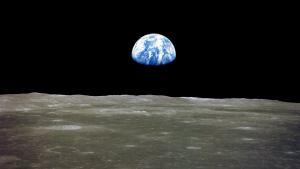Post
Never a
Miscommunication
24 April 2013
 NASA
NASAThe Earth and Moon are slowly moving apart. The moon’s distance from the Earth is not constant, because the Moon’s orbit is not perfectly circular. Over the course of a month the moon comes as close as 363,000 km and as far as 405,000 km due to the eccentricity of its orbit. However its average distance is slowly increasing.
We have very precise measurements of the Moon’s distance made by laser ranging. Retroreflectors were placed on the Moon during the Apollo missions, around the time when the picture above was taken. The retroreflectors let us bounce laser beams off the Moon, which lets us measure the distance of the Moon to within millimeters. What we’ve found after decades of observation is that the average distance of the Moon is increasing at a rate of about 3.8 centimeters per year. Not much compared to the range of its distance, but it builds up over time.
The reason for this increasing distance has to do with a property known as angular momentum. Angular momentum is a measure of the rotation of a system. In the case of the Earth and Moon, it includes the rotation of the Earth about its axis and revolution of the Moon around the Earth. The angular momentum of a system is constant, which means if the Earth loses angular momentum, the Moon must gain angular momentum.
It turns out the Earth does lose angular momentum. The days on Earth are getting longer by about 17 milliseconds per century. This slowdown is due to the tides of the Earth. As the oceans slosh back and forth, they slow down the Earth. But the tides are largely driven by the gravitational pull of the Moon, so as the Earth’s rotation slows, the Moon gains angular momentum. It moves just a bit faster in its orbit, and that causes its orbit to get just a bit larger.
This increasing distance to the Moon is often used by “young Earth” creationists, who argue that since the Moon was closer in the past, it can’t possibly be billions of years old. If you use the current rate of increase and the current average distance, you get a maximum age of the Moon of 10 billion years, which is much longer than the actual 4.5 billion year age of the Moon. But the argument is that if the Moon was closer, the tides would be stronger, therefore the rate of distance increase would have been greater in the past.
But we actually know the rate of increase was less in the past. We have geological records of ancient estuaries, where the tides were particularly high. With each tide a layer of silt was deposited, which creates tidal rhythmites. Since the length of the Earth’s year is the same in the past as it is now, you can look at seasonal variations in the rhythmites to determine how many days there were in an ancient year. For example, we find that 620 million years ago a day was about 22 hours long instead of 24. From this we can determine that over geologic scales the Moon’s orbit has been expanding by about 2.2 centimeters per year, which is less than the current level.
This difference is due to the fact that the Earth is changing shape. The Earth is not a perfect sphere. It is thicker at the equator than at the poles. Part of this is due to the Earth’s rotation, but part of it is due to weight of ice at the polar regions. At the end of the last ice age about 10,000 years ago the ice of the polar regions melted, and the Earth’s crust continues to spring back to a more spherical shape. That means even more angular momentum is transferred from the Earth to the Moon, making its distance increase faster than it would by tides alone.
So there’s no contradiction between the age of the Moon and the fact that it is slowly moving away from us.
Tides go in, tides go out. For billions of years.